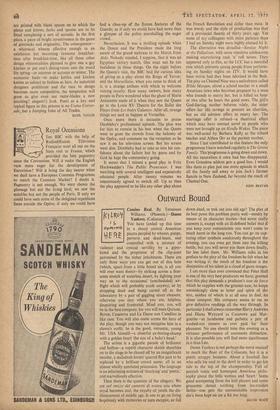John of All Trades
GIO PONT! the architect, designer, painter and editor who, with some associates, is the subject of a small exhibition at Liberty's, has been too glibly labelled a Universal Man, a title which should' properly be given to someone who does greatly more than turn his hand to a variety of enterprises. Ponti is perhaps best known here as the proprietor of. that very influential magazine of architecture and design Domus, a monument of Italian post-war sophistication. Marry the Architectural Review with House and Garden and add the element of stylishness to be found in the work of an Italian painter such as Campigli (to be seen now, incidentally, at the Marlborough Fine Art Ltd.) and you will have some impression of this efficient and useful glossy. Ponti is by nature an editor in all his activities. Very knowledge- able about twentieth-century forms, artistic ideas and clichés he edits them, without the intellectual and visionary fervour proper to the Uomo Uni- versale, into a lush and, I must say, an expensively vulgar condition. His most famous building, the Pirelli skyscraper in Milan, appears as a rewrite of the Mies van der Rohe skyscraper projects of 1919-21. His paintings are modernistic. His habit seems to be to take a design idea which has reached a stage of acceptance and then by the exercise of his undoubted, if rather eccentric, inventiveness to project it into terms which amount to unintentional parody, In furniture an idea of the times has been to integrate handles with the main body of a piece partly by conceal- ment partly by building them into the structure of door or drawer. A Ponti chest of drawers here,. with a white-painted front, has large projecting rectangular planes of unpainted wood which serve both as handles and 'as ornament. Words cannot convey the particular too-muchness, indeed absurdity, of the result. His lavatory bowl seems to parody• a certain kind of Industrial Design conception of what such a thing should look like. This interesting little exhibition shows a way in which an industrial designer may have designs upon our lives. The way which was recently indicated in an American design periodi- cal by a proud phrase 'The Race to Design.' Here is a set of cutlery, china and table-mats. The mats are printed with blank spaces on to which the plates and knives, forks and spoons arc to be fitted completing a sort of acrostic. In the first place, a piece of bright inventiveness in the game of gimmicks and originality. The consequence— a whimsical wheeze effective enough in an exhibition but becoming tiresome breakfast- time after breakfast-time, like all those other design whimsicalities planned to give one a gay kitchen or put one's dining-room into the mood for spring—or summer or autumn or winter. The economic basis—to make kettles and kitchen knives as subject to fashion as hats. As industrial designers proliferate and the race to design becomes more competitive, the temptation will grow to give even our razor-blades a new (exciting? elegant?) look. Ponti as a key and typical figure in this process is no Uomo Univer- sale, .but a Jumping John of All Trades.
BASIL TAYLOR



































 Previous page
Previous page